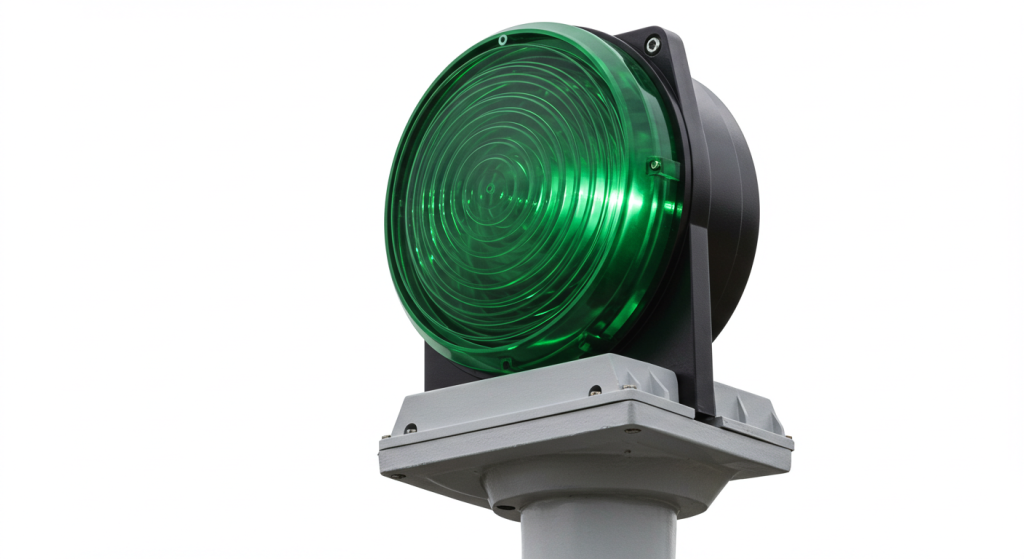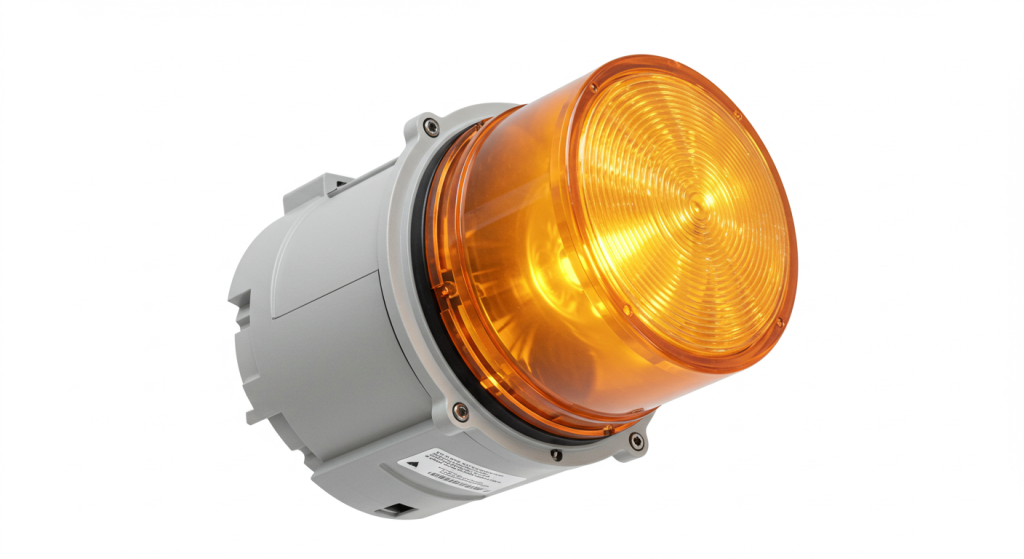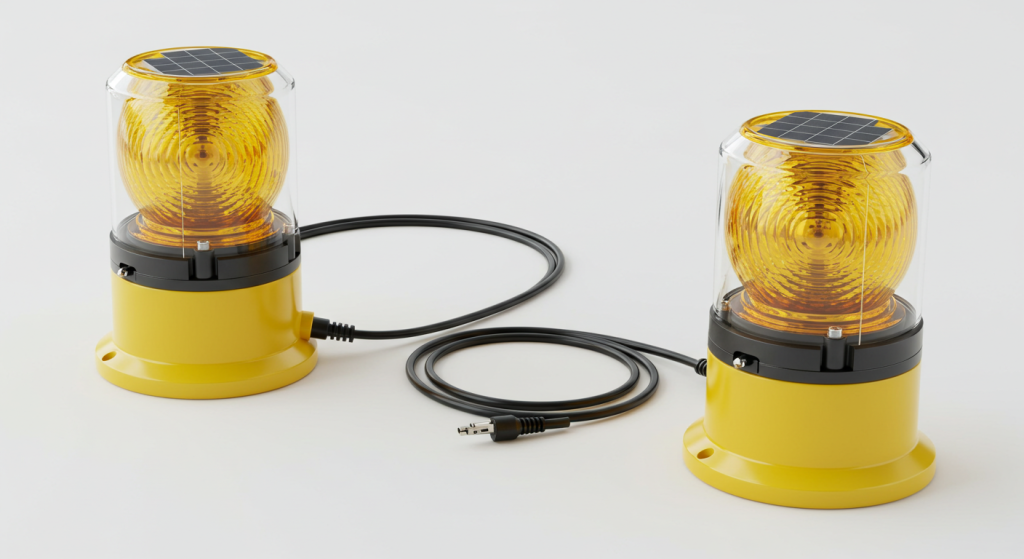The world of aviation is a delicate dance of precision and safety. From the moment an aircraft’s wheels leave the tarmac to its gentle descent back to earth, countless systems work in harmony to ensure a safe journey. While much attention is often given to the technology within the aircraft itself, equally vital are the unseen guardians of the sky: obstruction lights. These lights, perched atop towers, cranes, and buildings, act as beacons, guiding pilots away from potential hazards. Today, we’re witnessing a revolution in this vital safety system with the advent of solar powered obstruction lights, a sustainable and increasingly efficient alternative to traditional power sources. Imagine the future where runways are seamlessly illuminated with modern **Taxiway Landing Lights**, ensuring safe and efficient navigation on the ground, while above, solar obstruction lights shine brightly, marking the paths through the sky.

The Dawn of Solar Powered Obstruction Lights: A Sustainable Solution
The transition to solar powered obstruction lights represents more than just a simple swap of energy sources; it’s a leap towards a more sustainable, cost-effective, and reliable approach to aviation safety. For decades, obstruction lights relied on the electrical grid, a source that can be both costly and unreliable in remote or challenging locations. Now, the power of the sun is being harnessed to provide a clean, renewable, and dependable energy supply. This technology can also seamlessly integrate with other **airfield ground lights** creating a holistic approach to illumination on an aerodrome. The beauty of solar lies in its simplicity: the sun’s abundant energy is captured, stored, and then used to power these critical safety devices, minimizing environmental impact and reducing reliance on traditional power grids.
How Solar Powered Obstruction Lights Work: The Science Behind Sustainability
Understanding how these lights function is key to appreciating their value. At their heart, solar powered obstruction lights utilize photovoltaic (PV) panels to convert sunlight into electricity. This process involves photons from sunlight striking the solar panel’s semiconductor material, releasing electrons and creating an electrical current. This current is then used to charge a battery, typically a rechargeable lithium-ion or lead-acid battery. This battery stores the energy harvested during the day to power the LED obstruction light at night or during periods of low sunlight. The entire system is typically self-contained and autonomous, requiring minimal maintenance and supervision.

Components of a Solar Powered Obstruction Light System: A Breakdown
A typical solar powered obstruction light system consists of several essential components:
- Photovoltaic (PV) Panels: These are the heart of the system, responsible for converting sunlight into usable electricity.
- Battery: The battery stores the energy generated by the PV panels to power the lights when sunlight is unavailable.
- Charge Controller: This component regulates the flow of electricity between the PV panels, the battery, and the light, preventing overcharging or discharging of the battery, ensuring its long-term health.
- LED Light Fixture: The light source itself, typically using high-intensity LEDs for efficient and reliable performance.
- Mounting System: The structural component that holds the light in place on the obstruction. This often includes an adjustable mount for ideal panel orientation to the sun.
- Optional Monitoring System: Some sophisticated systems include remote monitoring capabilities, allowing operators to track performance and battery levels.
The Advantages of Solar Powered Obstruction Lights: A Clear Choice
The benefits of solar powered obstruction lights are numerous and far-reaching. Let’s delve into the key advantages these systems offer:
Environmental Sustainability: A Greener Footprint
One of the most compelling reasons to choose solar is its environmental friendliness. By harnessing the sun’s energy, these lights eliminate the need for fossil fuels and drastically reduce greenhouse gas emissions. This makes them a perfect solution for organizations committed to sustainable practices and a smaller carbon footprint. This contributes significantly to a cleaner environment and a more responsible approach to aviation infrastructure. This has a positive impact on local air quality, and aligns with global initiatives towards renewable energy sources.

Cost-Effectiveness: Long-Term Savings
While the initial investment in a solar powered obstruction light system may be slightly higher than a traditional system, the long-term cost savings are significant. These savings come from the elimination of electricity bills, reduced maintenance requirements, and the extended lifespan of LED technology. Over the life cycle of the system, the cost is often much less than a traditionally powered light, especially in areas where grid access is expensive or unavailable. With minimal maintenance requirements, there are reduced operational costs and less labour to keep the systems in top working condition.
Installation Flexibility: Accessing Remote Locations
Solar powered obstruction lights offer exceptional installation flexibility. They can be deployed in remote locations where connecting to the electrical grid is difficult or prohibitively expensive. This makes them ideal for marking obstructions in rural areas, on mountains, on wind farms, or on off-shore structures. The self-contained nature of these systems allows for quick and easy deployment without requiring complicated and expensive trenching or wiring. This flexibility means safety can be quickly and easily implemented even in the most challenging locations.
Enhanced Reliability: Dependable Operation
Solar powered obstruction lights are designed for reliable and continuous operation. The battery backup ensures that the lights will function even during periods of cloudy weather or at night. Modern battery technology provides consistent power for extended periods, minimizing downtime and ensuring uninterrupted safety. The systems are also built with high-quality components designed to withstand harsh environmental conditions, such as extreme temperatures, high winds, and rain. This robust design leads to reliable performance and peace of mind that the system will function as intended in the most demanding locations.
Reduced Maintenance: Less Downtime
These systems require minimal maintenance compared to traditional obstruction lights. The long lifespan of the LED lights and the battery minimize the need for frequent replacements. The robust design and high-quality components also mean that repairs are seldom needed, reducing operational downtime and labor costs. This reduction in maintenance provides operators with a hassle-free and dependable solution, ensuring the lights will keep running with minimal upkeep.
Scalability: Adapting to Different Needs
Solar powered obstruction light systems can be easily scaled to meet different needs and requirements. Whether you are lighting a small telecommunications tower or a large construction crane, solar systems can be designed to provide the appropriate level of illumination. This scalability allows for easy integration into existing infrastructure and ensures that you can create lighting solutions customized to each specific application. With this flexibility, you can adapt systems to your specific needs, ensuring the proper level of visibility for all your obstructions.
Applications of Solar Powered Obstruction Lights: A Versatile Solution
The versatility of solar powered obstruction lights makes them suitable for a wide range of applications across various industries. Here are some notable examples:
Aviation: Ensuring Safe Air Travel
In aviation, solar powered obstruction lights play a vital role in marking tall structures, such as communication towers, buildings, and wind turbines, that could pose a risk to aircraft. These lights help pilots identify potential hazards, especially during nighttime or low-visibility conditions. The reliable and sustainable nature of solar power makes it a perfect fit for this crucial application, as they offer consistent and dependable illumination which is essential for aviation safety. Integration with **airfield ground lights** could create a safer environment for aircraft movement.
Construction: Marking Cranes and Equipment
Construction sites often utilize cranes and other tall equipment that can pose a hazard to low-flying aircraft. Solar powered obstruction lights provide a convenient and flexible solution for marking these hazards. The portability of the systems means they can be easily moved as equipment changes locations. This helps ensure that construction sites are marked clearly, minimizing the risk of accidents. With the need for minimal maintenance and robust construction, they are an ideal solution for harsh working environments.
Telecommunications: Illuminating Communication Towers
Telecommunication towers are often located in remote areas where grid access may be limited or expensive. Solar powered obstruction lights provide a reliable and cost-effective way to mark these towers, ensuring safe air navigation. The reduced maintenance requirements of these systems make them ideal for sites that are difficult to access, saving companies time and money. The use of solar helps minimize operating costs and promotes a sustainable approach to telecommunications infrastructure.
Wind Farms: Marking Turbines
Wind turbines, which are often located in open, remote areas, can pose a risk to aircraft. Solar powered obstruction lights provide an excellent way to mark these structures, ensuring their visibility. They help ensure aviation safety without the need for extensive wiring, and contribute to the environmental responsibility of the wind farm operation. The long lifespan of LEDs helps reduce the frequency of maintenance, which can be difficult due to location and weather conditions. The ability to operate off-grid is also a major advantage to these types of installations.
Offshore Installations: Marking Platforms
Offshore oil and gas platforms, as well as other maritime structures, often require obstruction lighting to ensure the safety of both air and sea traffic. Solar powered systems provide a reliable and self-sufficient lighting solution for these often-isolated and harsh environments, reducing the need for complicated and expensive power connections. The rugged design ensures they can withstand the corrosive effects of salt water and the harsh marine environment.
Choosing the Right Solar Powered Obstruction Lights: Key Considerations
Selecting the appropriate solar powered obstruction light system is crucial for ensuring long-term performance and reliability. Here are key factors to consider when choosing a system:
Solar Panel Efficiency: Maximizing Energy Capture
The efficiency of the solar panel is critical for maximizing energy capture. Look for panels with high conversion rates to ensure that the battery receives adequate charging, even under suboptimal sunlight conditions. The panel size and quality should be matched to the specific location, taking into account local weather patterns and solar irradiance. This is paramount to ensuring reliable performance in diverse environments.
Battery Capacity: Providing Backup Power
The battery capacity should be sufficient to power the lights throughout the night, or through periods of prolonged cloud cover. Choose a battery with the appropriate capacity to meet your specific requirements. Pay attention to battery type, as this can affect battery lifespan and performance. The lifespan of the battery is also an important factor to ensure long-term, reliable operation. Choose brands and models known for quality and proven performance.
Light Intensity and Visibility: Ensuring Safety
The light intensity must be sufficient to meet the required visibility standards for your application. Consider the type of light (e.g., steady burning or flashing) and color (e.g., red, white, or amber) to ensure proper visibility from the required distance. The lights must also conform to the applicable standards set by aviation regulatory bodies. The chosen light intensity should be adequate to meet the required visibility at all times, ensuring the safety of aircraft.
Mounting Options: Secure and Durable Installation
The mounting system should be secure, durable, and able to withstand the environmental conditions at the installation site. Consider factors such as wind loads, temperature fluctuations, and the structure’s material when choosing a mounting system. A sturdy mounting system is essential for ensuring the longevity and reliability of the lighting system. Ensure the installation is appropriate for the location and can withstand long-term environmental stresses.
System Monitoring and Control: Remote Access and Diagnostics
Consider systems with remote monitoring and control capabilities. These features allow you to track the performance of the system, monitor battery levels, and receive alerts if there are any issues. This capability can reduce downtime and maintenance, while also providing peace of mind that the system is functioning as intended. This will contribute to a smooth, uninterrupted operation, reducing the need for expensive site visits.
Regulatory Compliance: Meeting Industry Standards
Ensure that the solar powered obstruction light system meets all relevant industry regulations and standards. Choose a system certified by aviation regulatory bodies such as the FAA or ICAO. This guarantees that the lighting system is compliant, and that it will provide the visibility and dependability required for safe aviation operation. This reduces risks of non-compliance, and is an important factor in choosing a long-term, reliable system.
The Future of Solar Powered Obstruction Lights: Innovation and Advancement
The technology behind solar powered obstruction lights is continuously evolving, promising even more advanced and efficient systems in the future. Ongoing research and development efforts are focused on further enhancing the performance, reliability, and cost-effectiveness of these systems. We are witnessing advancements in the areas of solar panel technology, battery storage, and intelligent control systems, which are all contributing to their increased adoption across many applications.
Improved Solar Panel Technology: Increasing Efficiency
Ongoing research is focused on increasing the efficiency of solar panels, allowing them to generate more electricity from less sunlight. This will result in smaller, more efficient solar panel systems, which will make these lights more affordable and versatile. The ability to harvest energy even in lower light conditions would further improve their reliability. This advancement will lead to greater adoption of this technology in many different applications.
Advanced Battery Technology: Extending Lifespan and Performance
Advanced battery technology, including new materials and designs, will increase the lifespan and performance of batteries used in solar powered obstruction lights. The use of solid-state batteries or other new technologies will result in more efficient energy storage and will increase the operating time of the lights. It will also lead to a reduction in the frequency of battery replacement, reducing long term operating costs. This will ensure the system performs reliably even in demanding environments, ensuring a constant, dependable source of light.
Intelligent Control Systems: Optimized Performance
Future systems are likely to incorporate advanced intelligent control systems that optimize the performance of the lights in real time. These systems could automatically adjust light output, manage energy usage, and perform remote diagnostics. This would minimize maintenance needs, and maximize performance, which would contribute to the system’s reliability, and would ensure continuous operation. These intelligent systems will revolutionize how solar powered obstruction lights are managed and monitored.
Integration with Smart Technologies: Seamless Connectivity
Solar powered obstruction lights will be integrated with smart technologies, including cloud-based platforms and the Internet of Things (IoT). This integration would allow for remote monitoring, control, and data analysis, enabling greater flexibility and operational efficiency. Integration with smart technology will also contribute to more intelligent monitoring and management systems, maximizing the efficiency of the lighting systems. This seamless integration with other technologies will ensure these systems remain at the cutting edge of this technology.
The Benefits of Solar Powered Obstruction Lights in Summary
In conclusion, solar powered obstruction lights offer a compelling and sustainable alternative to traditional lighting systems for a wide range of applications. The advantages in terms of environmental sustainability, cost savings, installation flexibility, reliability, and ease of maintenance make them an increasingly popular choice for organizations around the globe. As the technology continues to evolve, it is likely that solar powered obstruction lights will become even more efficient, affordable, and versatile. The switch to this technology not only improves safety, but is also better for the environment and the long term cost of operations.
Here’s a summary of the key benefits:
| Benefit | Description |
|---|---|
| Environmental Sustainability | Reduces reliance on fossil fuels and decreases greenhouse gas emissions. |
| Cost-Effectiveness | Long-term savings due to reduced energy and maintenance costs. |
| Installation Flexibility | Easy deployment in remote locations and challenging environments. |
| Enhanced Reliability | Dependable performance with battery backup, minimizing downtime. |
| Reduced Maintenance | Long-life components and minimal repair requirements. |
| Scalability | Easily adaptable to different needs and applications. |
| Safety | Ensures compliance with aviation safety standards. |
| Self-Sufficiency | Operates autonomously from the electrical grid. |
| Technology Advancement | Benefiting from continued improvements in solar panel and battery technologies. |
The future of obstruction lighting is undoubtedly solar powered. The numerous benefits make it the most logical and sustainable choice for applications where the safety of air navigation is vital. By adopting solar powered obstruction lights, organizations can make a positive impact on the environment, reduce costs, and provide a safe and dependable solution. The technology is continuing to develop, meaning solar lighting will continue to improve over the years to come. The switch to solar is more than just a lighting upgrade, it’s an investment in a sustainable, safer, and more cost-effective future.
Embracing solar powered obstruction lights isn’t just about adopting a technology; it’s about championing a sustainable future where safety and environmental responsibility go hand-in-hand. By choosing this approach, we contribute to a greener planet while simultaneously enhancing the safety of our skies, and the operations of airports and similar facilities, by providing reliable and dependable lighting. With the addition of **Taxiway Landing Lights**, and enhanced **airfield ground lights**, we can create a safe and environmentally conscious experience for all.